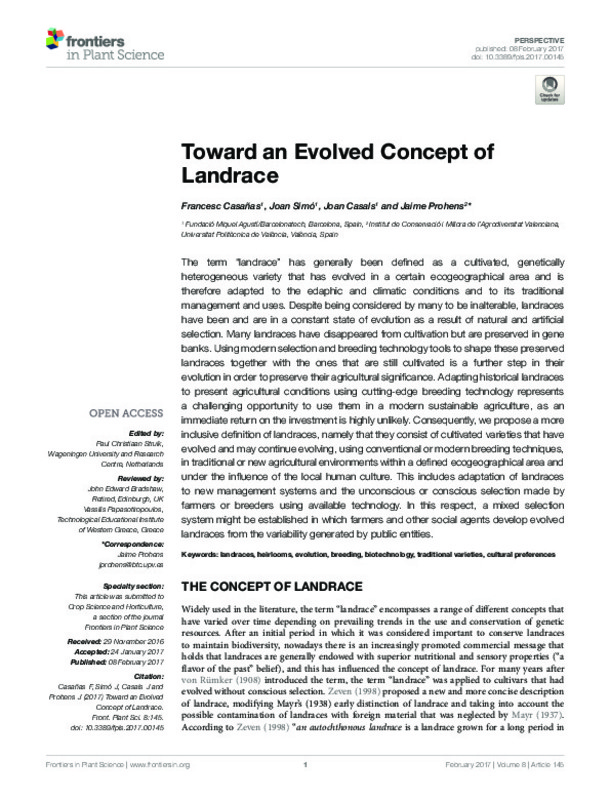Almirall, A., Bosch, L., Romero del Castillo, R., Rivera, A., & Casañas, F. (2010). ‘Croscat’ Common Bean (Phaseolus vulgaris L.), a Prototypical Cultivar within the ‘Tavella Brisa’ Type. HortScience, 45(3), 432-433. doi:10.21273/hortsci.45.3.432
Bitocchi, E., Bellucci, E., Rau, D., Albertini, E., Rodriguez, M., Veronesi, F., … Nanni, L. (2015). European Flint Landraces Grown In Situ Reveal Adaptive Introgression from Modern Maize. PLOS ONE, 10(4), e0121381. doi:10.1371/journal.pone.0121381
BITOCCHI, E., NANNI, L., ROSSI, M., RAU, D., BELLUCCI, E., GIARDINI, A., … PAPA, R. (2009). Introgression from modern hybrid varieties into landrace populations of maize (Zea maysssp.maysL.) in central Italy. Molecular Ecology, 18(4), 603-621. doi:10.1111/j.1365-294x.2008.04064.x
[+]
Almirall, A., Bosch, L., Romero del Castillo, R., Rivera, A., & Casañas, F. (2010). ‘Croscat’ Common Bean (Phaseolus vulgaris L.), a Prototypical Cultivar within the ‘Tavella Brisa’ Type. HortScience, 45(3), 432-433. doi:10.21273/hortsci.45.3.432
Bitocchi, E., Bellucci, E., Rau, D., Albertini, E., Rodriguez, M., Veronesi, F., … Nanni, L. (2015). European Flint Landraces Grown In Situ Reveal Adaptive Introgression from Modern Maize. PLOS ONE, 10(4), e0121381. doi:10.1371/journal.pone.0121381
BITOCCHI, E., NANNI, L., ROSSI, M., RAU, D., BELLUCCI, E., GIARDINI, A., … PAPA, R. (2009). Introgression from modern hybrid varieties into landrace populations of maize (Zea maysssp.maysL.) in central Italy. Molecular Ecology, 18(4), 603-621. doi:10.1111/j.1365-294x.2008.04064.x
Bosch, L., Casañas, F., Sánchez, E., Pujolà, M., & Nuez, F. (1998). Selection L67, a Pure Line with True Seed Type of the Ganxet Common Bean (Phaseolus vulgaris L.). HortScience, 33(5), 905-906. doi:10.21273/hortsci.33.5.905
Casals, J., Bosch, L., Casañas, F., Cebolla, J., & Nuez, F. (2010). Montgrí, a Cultivar within the Montserrat Tomato Type. HortScience, 45(12), 1885-1886. doi:10.21273/hortsci.45.12.1885
Causse, M., Desplat, N., Pascual, L., Le Paslier, M.-C., Sauvage, C., Bauchet, G., … Bouchet, J.-P. (2013). Whole genome resequencing in tomato reveals variation associated with introgression and breeding events. BMC Genomics, 14(1), 791. doi:10.1186/1471-2164-14-791
Ellstrand, N. C. (2014). Is gene flow the most important evolutionary force in plants? American Journal of Botany, 101(5), 737-753. doi:10.3732/ajb.1400024
Ellstrand, N. C., Meirmans, P., Rong, J., Bartsch, D., Ghosh, A., de Jong, T. J., … Hooftman, D. (2013). Introgression of Crop Alleles into Wild or Weedy Populations. Annual Review of Ecology, Evolution, and Systematics, 44(1), 325-345. doi:10.1146/annurev-ecolsys-110512-135840
Ellstrand, N. C., Prentice, H. C., & Hancock, J. F. (1999). Gene Flow and Introgression from Domesticated Plants into Their Wild Relatives. Annual Review of Ecology and Systematics, 30(1), 539-563. doi:10.1146/annurev.ecolsys.30.1.539
Ferreira, J. J., Campa, A., Pérez-Vega, E., Rodríguez-Suárez, C., & Giraldez, R. (2011). Introgression and pyramiding into common bean market class fabada of genes conferring resistance to anthracnose and potyvirus. Theoretical and Applied Genetics, 124(4), 777-788. doi:10.1007/s00122-011-1746-x
García-Martínez, S., Grau, A., Alonso, A., Rubio, F., Valero, M., & Ruiz, J. J. (2011). UMH 1200, a Breeding Line within the Muchamiel Tomato Type Resistant to Three Viruses. HortScience, 46(7), 1054-1055. doi:10.21273/hortsci.46.7.1054
Gompert, Z., & Buerkle, C. A. (2016). What, if anything, are hybrids: enduring truths and challenges associated with population structure and gene flow. Evolutionary Applications, 9(7), 909-923. doi:10.1111/eva.12380
Harlan, J. R. (1965). The possible role of weed races in the evolution of cultivated plants. Euphytica, 14(2), 173-176. doi:10.1007/bf00038984
Jarvis, D. I., & Hodgkin, T. (1999). Wild relatives and crop cultivars: detecting natural introgression and farmer selection of new genetic combinations in agroecosystems. Molecular Ecology, 8(s1), S159-S173. doi:10.1046/j.1365-294x.1999.00799.x
Messeguer, J. (2003). Plant Cell, Tissue and Organ Culture, 73(3), 201-212. doi:10.1023/a:1023007606621
Nogué, F., Mara, K., Collonnier, C., & Casacuberta, J. M. (2016). Genome engineering and plant breeding: impact on trait discovery and development. Plant Cell Reports, 35(7), 1475-1486. doi:10.1007/s00299-016-1993-z
Prohens, J., Muñoz-Falcón, J. E., Rodríguez-Burruezo, A., Ribas, F., Castro, Á., & Nuez, F. (2009). ‘H15’, an Almagro-type Pickling Eggplant with High Yield and Reduced Prickliness. HortScience, 44(7), 2017-2019. doi:10.21273/hortsci.44.7.2017
Simó, J., del Castillo, R. R., Almirall, A., & Casañas, F. (2012). ‘Roquerola’ and ‘Montferri’, First Improved Onion (Allium cepa L.) Cultivars for «Calçots» Production. HortScience, 47(6), 801-802. doi:10.21273/hortsci.47.6.801
Villa, T. C. C., Maxted, N., Scholten, M., & Ford-Lloyd, B. (2005). Defining and identifying crop landraces. Plant Genetic Resources, 3(3), 373-384. doi:10.1079/pgr200591
Zeven, A. C. (1998). Euphytica, 104(2), 127-139. doi:10.1023/a:1018683119237
[-]









